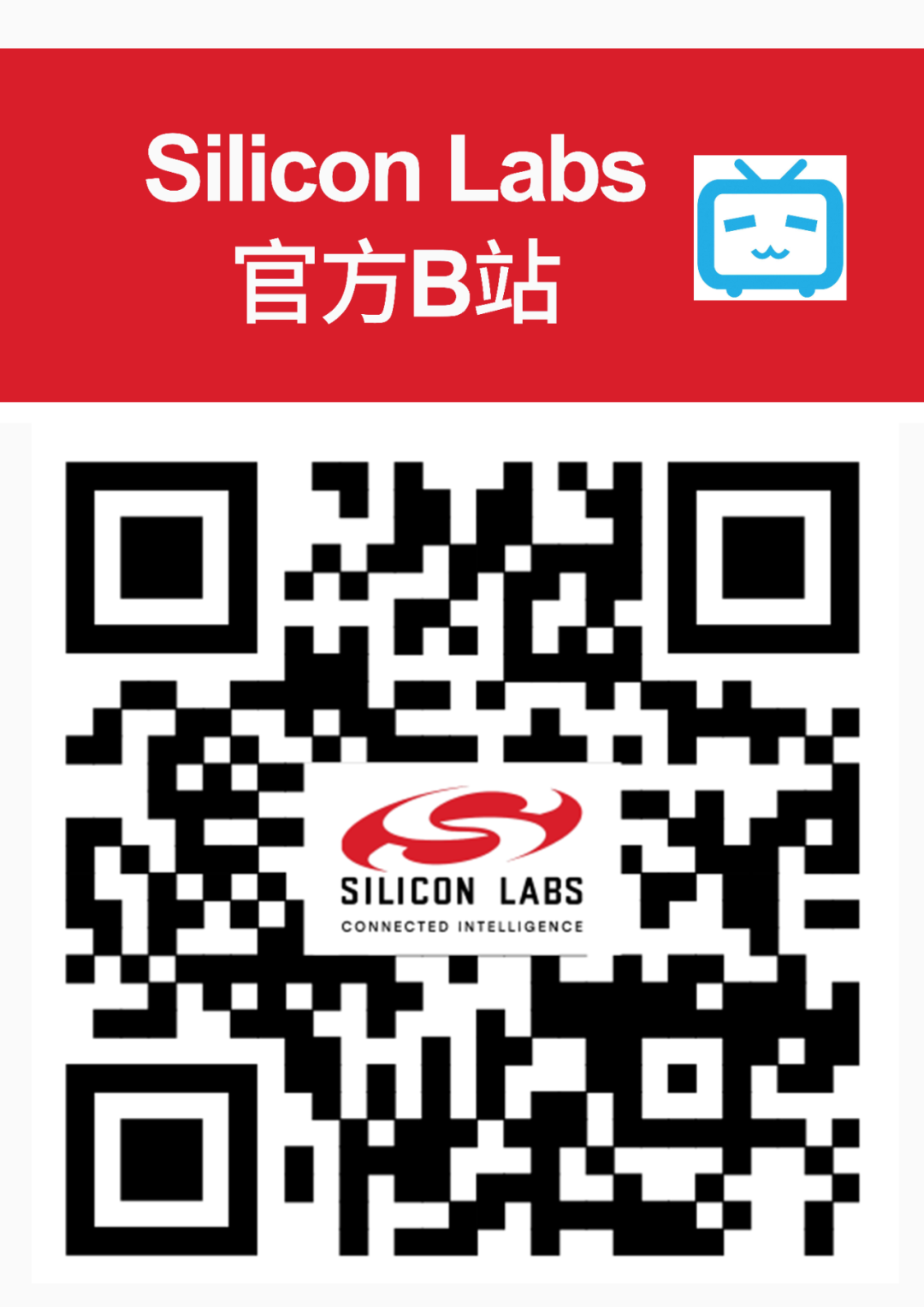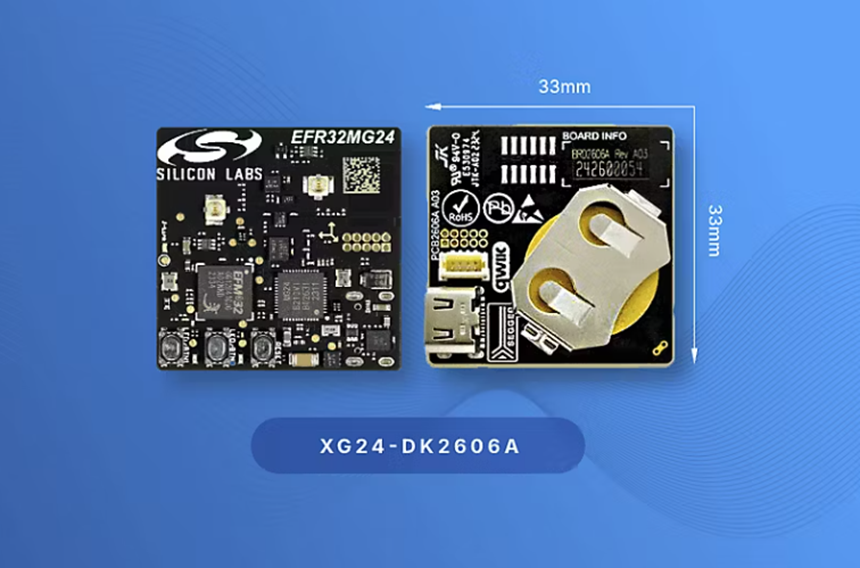
In Bluetooth channel sounding (Channel Sounding) applications, the design scheme should always consider adding a second antenna. As shown in Silicon Labs‘ low-power Bluetooth (Bluetooth LE) channel sounding antenna guideline document – AN1493: Antenna Design Guidelines for BLE Channel Sounding, even in cases where size is constrained, adding a second antenna is feasible and helps significantly improve location accuracy.
Our latest launch, the EFR32xG24 -DK2606A Bluetooth channel sounding development board provides a design example based on best practices, supporting two antennas within a size of less than 33 x 33 millimeters. The size itself is larger than the final product because the Bluetooth channel sounding development board is equipped with a complete debugging circuit on board.
Introduction to the BRD2606 Bluetooth Channel Sounding Evaluation Platform
All tests in this blog were conducted using the Bluetooth channel sounding development kit BRD2606, as it is a highly versatile Bluetooth channel sounding evaluation platform. Consider the following key features:
-
Implementation of best practices for dual antenna support, following all published guidelines.
-
Optional operation powered by button batteries.
-
Compact packaging suitable for prototyping and easy placement in space-constrained environments.
-
On-board debugging and terminal output capabilities provided through on-board circuits.
Combining the above features of this development board, along with Silicon Labs’ compliance with SIG standards, support for Bluetooth channel sounding functionality in the 6.0 protocol stack, quality production-grade initiator and reflector example applications, and highly configurable performance features such as antenna enablement, combined with the Bluetooth channel sounding analyzer GUI in Simplicity Studio, gives Silicon Labs developers and customers a robust and reliable platform for extensive evaluation.
We designed the BRD2606 in a keychain-like form factor, but this design is also suitable for asset tracking applications. For any system with low-power Bluetooth capabilities that can benefit from some form of location awareness, Bluetooth channel sounding is a highly attractive value-added feature. With this compact development board, we look forward to seeing developers uncover innovative applications for Bluetooth channel sounding that extend beyond the scenarios currently emphasized by the Bluetooth Special Interest Group.
Start Your Journey with Bluetooth Channel Sounding Applications
Get more information about our new dual-antenna board: https://cn.silabs.com/development-tools/wireless/efr32xg24-channel-sounding-dev-kit
Most of the data in this blog post comes from our antenna guideline document, and we encourage everyone new to Bluetooth channel sounding to read this document: https://www.silabs.com/documents/public/application-notes/an1493-antenna-design-guidelines-for-ble-channel-sounding.pdf
We also provide performance metrics on docs.silabs.com, along with the complete API specifications for our Bluetooth channel sounding library: https://docs.silabs.com/rtl-lib/8.2.0/rtl-lib-channel-sounding-getting-started/
We look forward to developers introducing new features and improvements to our channel sounding solutions in future development cycles. In the process, we will optimize performance by minimizing current consumption through optimizing RF air transmission time and algorithm execution time while enhancing accuracy and stability.
Next, we will discuss how the core specification 6.0 standardizes the use of multiple antennas.
Multi-Antenna Design Helps Channel Sounding Achieve0.5 Meter Target Accuracy
When Bluetooth channel sounding was incorporated into the Bluetooth core specification 6.0, the Bluetooth Special Interest Group (Bluetooth SIG) set a requirement to achieve 0.5 meter target accuracy in most scenarios. This accuracy target presents a significant challenge, as it is often difficult, if not impossible, to reliably achieve 0.5 meter accuracy without using multiple antennas. Factors such as the relative orientation between devices, the human body, obstacles in the environment, and multipath interference all contribute to limiting the reliability of single-antenna ranging using Bluetooth channel sounding.
Bluetooth channel sounding is a bidirectional ranging process, where the initiator and reflector alternately send and receive signals and data packets, making the aforementioned challenges even more daunting. The two ends are functionally quite symmetrical, especially when compared to Bluetooth direction finding technology, which defines various asymmetries in functionality and antenna requirements between the two endpoints. Because Bluetooth channel sounding is symmetrical, both communication endpoints must understand each other’s antenna capabilities and switching modes to accurately collect data, analyze it, and determine relative distances.
Like any new feature, the goal of Bluetooth channel sounding is to achieve interoperability. Standardizing the solution to enable “plug and play” between phones and devices provides product designers with the assurance they need for global product deployment. The only way to achieve this “plug and play” functionality with multiple antennas is to standardize the way antennas are used in conjunction with other processes of Bluetooth channel sounding.
While other aspects of this technology are considered leading-edge and groundbreaking, achieving flexible standardization of antenna switching within a controlled range is equally crucial for Bluetooth channel sounding. This feature ensures that Bluetooth channel sounding can deliver on its promise of maximizing interoperability while achieving robust accuracy.
Why Products Should Be Designed with Multiple Antennas
When the antennas of two wireless devices are tuned to the same frequency, and there is a clear line of sight between their circuit boards and/or sufficient power to penetrate all materials and interference sources in the environment for signal reception, communication between the two devices is optimal. Walls and obstacles, including the human body, floors, and ceilings, as well as other RF signals, can adversely affect the communication capabilities between the two antennas.
Additionally, the relative orientation between antennas can also pose problems. In environments with movable, battery-powered IoT devices, the orientation of device A‘s antenna relative to device B‘s antenna is unpredictable and uncontrollable. Unfortunately, certain orientations can create frequency-dependent null points, leading to significant signal amplitude attenuation. If the placement angle and distance between two IoT devices happen to fall into a certain situation, they may be unable to communicate.
In asynchronous connection-oriented logic (ACL) transmission communication based on low-power Bluetooth connections, these null points often lead to packet retransmissions and may even cause connection interruptions. In Bluetooth channel sounding, the impact can be more subtle. Phase information distortion can occur in IQ data from PBR measurements, introducing errors into distance estimation algorithms.
Devices with multiple antenna orientations can exchange phase-based data from the same channel from different antenna orientations, increasing the likelihood of obtaining undistorted IQ data that describes that channel.
Undistorted IQ data enables highly accurate distance estimation, resulting in higher quality end solutions.
How Antenna Switching Works in Channel Sounding
In terms of antenna switching, the Bluetooth core specification 6.0 standardizes three basic methods.
-
Function swapping
-
Mode 2 phase-based ranging operation
-
IQ data structure swapping
During the function swapping process, the peripheral device in the connection responds to a request indicating the maximum number of antennas it can use and the number of antenna paths it can support. Antenna paths are literally the paths through which the antenna on circuit board A communicates with the antenna on circuit board B. Some devices may not support multiple antenna paths due to circuit board design or memory limitations.
Before the process begins, the controller selects a configuration and communicates it to the reflector so that both parties can understand the number of antenna paths and antenna configurations.
In the Bluetooth channel sounding steps using Mode 2 phase-based ranging, the initiator sends a single-tone signal on the channel through each antenna path in the order known to the reflector. The reflector then sends a single-tone signal on the same channel along the same sequence of antenna paths.
The Bluetooth channel sounding algorithm running on the initiator will save all antenna path-specific IQ data on that channel, but before deriving the distance, it also needs the corresponding IQ data from the reflector.
During the process of retrieving data from the reflector to the initiator (achieved through LE ACL connection), IQ data needs to be transmitted according to a predefined data structure. This data structure is also defined as part of the ranging profile, which was adopted a few months after the core specification update.
Silicon Labs supports all of the above functions through the Bluetooth channel sounding solution running on the EFR32xG24. Our Bluetooth protocol stack is certified to meet the requirements of 6.0, and our implementation of the ranging profile is certified. All these features can be evaluated using BRD2606.
Test Results of Single Antenna Designs
Not all designs can follow every design best practice. Limitations in circuit board or cost may force a design to use only a single antenna. The reliability of distance estimation algorithms may decrease, but even so, these devices still meet the conditions for Bluetooth channel sounding. Operating with only one antenna path, i.e., both device A and device B have only one antenna path, is still a viable design choice.
The following tests were conducted in an office environment, which produces reflections and multipath interference. The tests were performed using BRD2606, but each development board used only one antenna, forming one antenna path.
In these eight test runs, the two development boards were placed 11 meters apart, and one of the development boards was rotated to ensure that the antennas on both boards were in the same polarization or cross-polarization state.
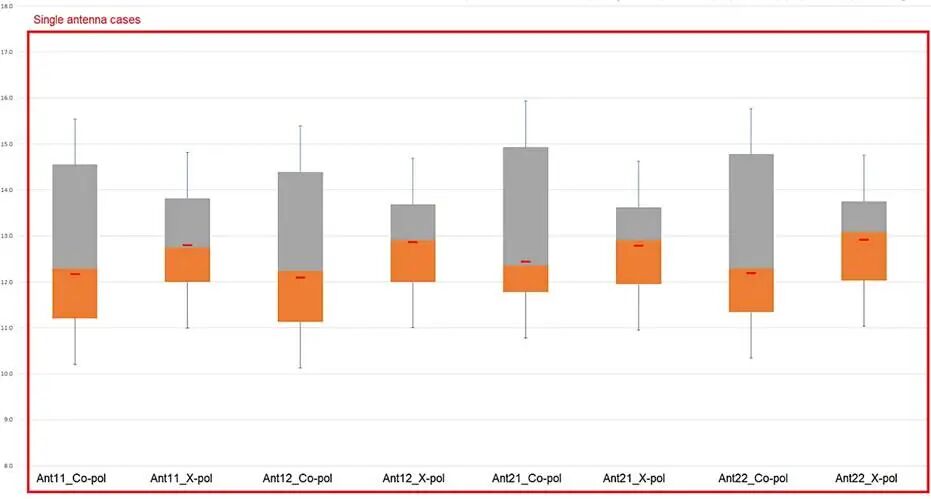
In this test, the cross-polarized antenna performed best, with measurement errors typically within +/-2 meters. The performance of the same-polarized antenna was poorer, with most results showing errors of +/-3 meters or greater.
Please note that this performance is still far more reliable than attempting to measure distance using RSSI, which was the only available standardized distance estimation method before Bluetooth channel sounding was adopted.
As shown in the figure below, when both antennas on the BRD2606 development board are enabled, forming up to 4 antenna paths, the measurement results are much more reliable, with most measurements’ errors well controlled within 1 meter. Note that in these tests, the same-polarized test cases were conducted using two BRD2606 development boards oriented in the same horizontal direction, while the cross-polarized tests were performed with one development board placed vertically and the other horizontally.
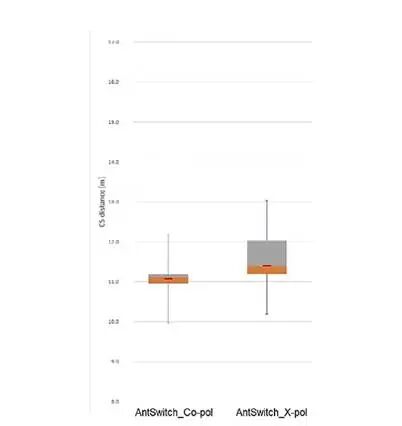
At Least One Device Should Support Dual Antenna Design
Many applications of Bluetooth channel sounding often follow a “Locator”/”Tag” model. In these cases, the locator end is usually stationary and larger in size, but may face challenges in device coexistence and competition for circuit board space with other antennas.
The tag end is likely to be movable, and its size constraints may even be smaller than the keychain form factor, making it difficult to support dual antennas. For these situations, we believe that supporting two or more antennas on the fixed “locator” end is at least somewhat beneficial.
The chart below shows three sets of data collected by rotating a BRD2606 that only activated a single antenna, which was 10 meters away from another BRD2606 that activated two antennas. In most distance estimates during the rotation of one development board, we see errors around +/- 1 meter, but there are also some notable outliers.
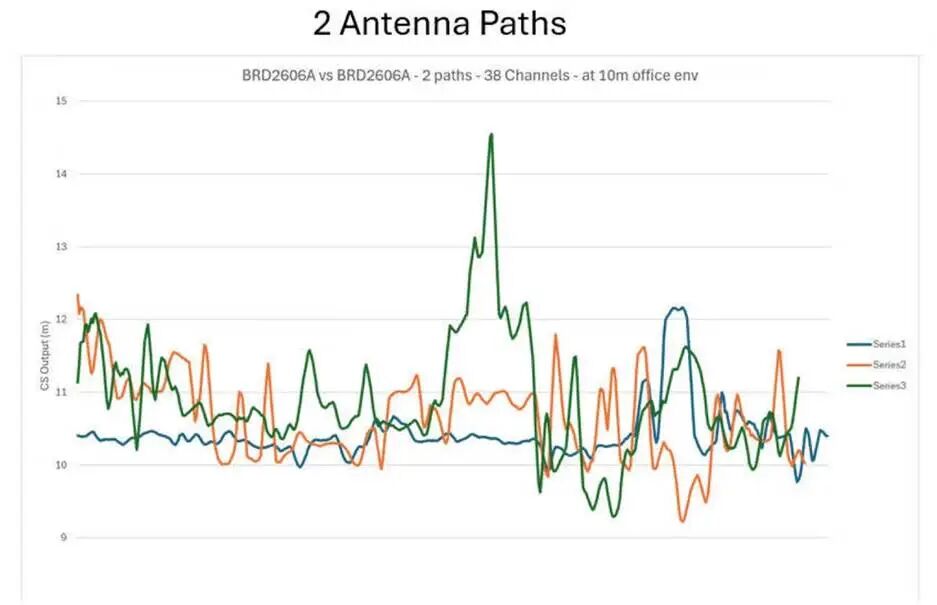
While this may seem concerning, it is important to consider what level of reliability and accuracy is sufficient for specific applications. For example, a tracker installed on a smart pallet with an area of 2-4 square meters for tracking within warehouse space may not require the same level of precision as a car’s keyless entry and ignition application.
By enabling the second antenna on the second development board, forming four antenna paths, performance can be significantly improved, with all results from three test runs achieving accuracy within 0.5 meters.
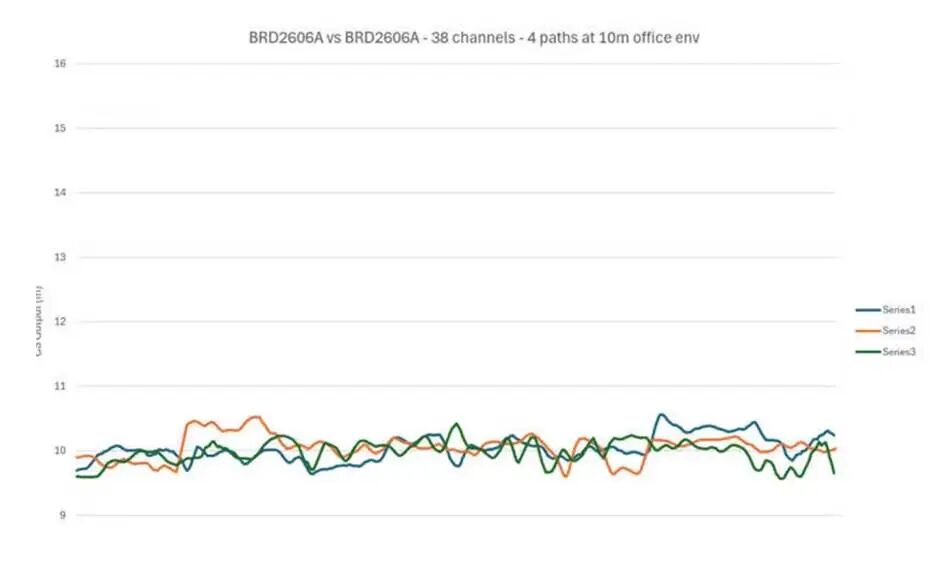
Why Not Always Use Four Antenna Paths?
As shown by the results above and other tests, four antenna paths can provide more reliable and accurate data regardless of the orientation of the development boards and environmental conditions. For detailed test data, see: https://www.silabs.com/documents/public/application-notes/an1493-antenna-design-guidelines-for-ble-channel-sounding.pdf
However, in some cases, using four antenna paths may not be feasible. As mentioned earlier, limitations in circuit board design may restrict the number of antennas that can be used in a design. Other factors include constraints on power consumption and update rates, or considerations for RF air time occupancy.
Using Multiple Antennas Increases Time Spent in the Three Stages of Channel Sounding:
-
In PBR ranging, enabling more antenna paths increases the duration of each step.
-
During the process of transmitting IQ data from the reflector to the host, multiple antenna paths increase the size of the data structure transmitted via LE ACL.
-
In processing, the data generated by multiple antenna paths leads to exponential growth in the execution time of distance estimation algorithms.
The table below shows update rates and execution times for the distance estimation algorithm (SiSDK in 24Q4-GA) as a function of the number of antennas used. We also varied the channel spacing settings between 1 MHz spacing (72 channels) and 2 MHz spacing (37 channels) to demonstrate how other factors, in addition to the number of antennas, significantly impact update rates and processing times.
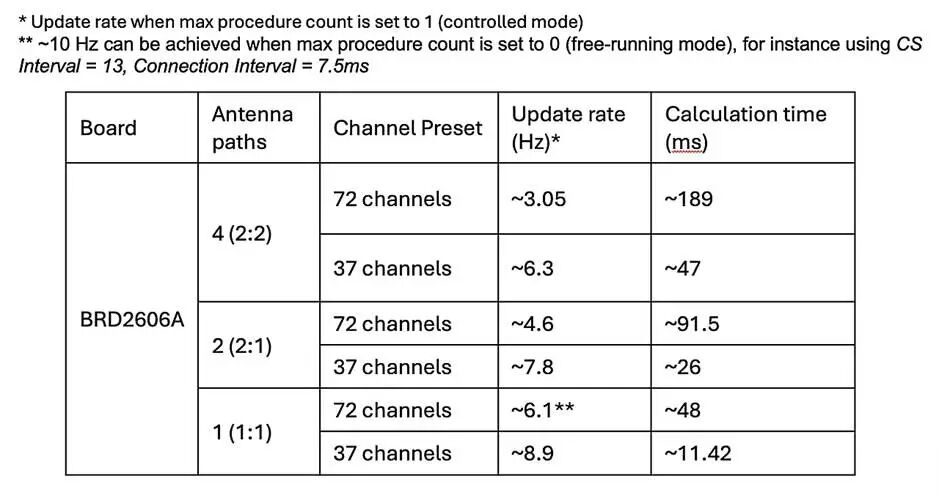 Scan the QR code below to follow Silicon Labs’ social media platforms
Scan the QR code below to follow Silicon Labs’ social media platforms

